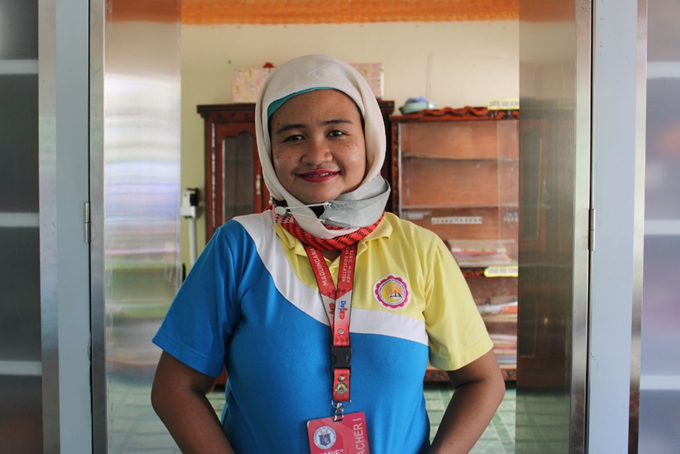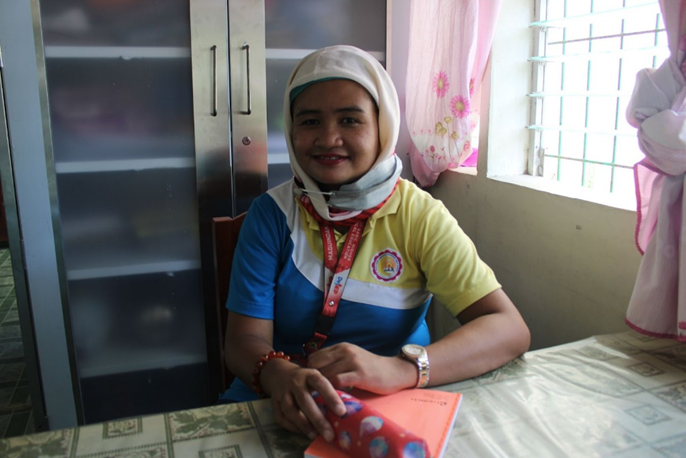RIGHTS IN CRISIS AND EMERGENCIES
Teaching peace in a conflict-ridden area
Hanibai Kadil, 35, has been teaching literature to high school students at Datu Tahir National High School in Libutan, Mamasapano since 2009. At age 15, she read any book she could put her hands on. Her father’s meager salary as a laboratory analyst at the Department of Agriculture allowed her to rent books at Cotabato City where she studied from primary school to college. She fell in love with reading because of Barbara Cartland’s historical romantic tales, which bred to her love for Rowling and Tolkien.

Hanibai at Datu Tahir National High School
Her passion for writing was developed when she joined the university publication, to which she served as its editor-in-chief in her fourth year. She wanted to be a journalist, but was told to go into teaching instead. “Kung magtuturo ako, literature ang ituturo ko” (If I become a teacher, I want to teach literature), she told herself.
She did not become a journalist as she wished she would be when she was younger, but she gets to teach kids about books and writing. Last September 23, Haniebai was one of the 20 teachers from Maguindanao province who attended the training for the Media for Peace and Development module piloting. The two-part module covered theoretical and conceptual background on peace and violence aimed at arming future media practitioners with ample information to more accurately report news. It also discussed peace journalism as a tool for peacebuilding using media platforms.
“Nung binasa ko yung module, napa-reflect ako sa mga activities na ginagawa ko sa classroom lalo na noong may face-to-face classes pa. Narealize ko na nagagawa ko na rin pala ang pag incorporate ng peacebuilding lessons sa mga klase ko, kahit man hindi consciously.” (When I read the module, I reflected on the activities I employ in my classes especially when there were face-to-face classes. I realized that I have been incorporating peacebuilding lessons to my classes, albeit unconsciously.)
Hanibai witnessed the catharsis of writing through her students. “Marami sa kanila naiiyak tuwing nagro-role play sila ng mga skits na sila rin ang nagsulat. Kahit yung mga sinusulat nilang essays, ramdam mo na inugat nila sa sarili nilang mga karanansan” (Many of them would tear up when role-playing skits that they themselves wrote. Even when I read the essays they write, I really feel that these are rooted in their personal experiences.)

Hanibai on her desk at Datu Tahir National High School.
More than anything, the Media for Peace and Development module serves as a guide for her to strengthen and continue the efforts in incorporating peacebuilding lessons to her classes. It has not been more clear to her how misinformation can incite hatred and violence. This is what she aims to instill to her students as she prepares to pilot the module.
Many of the students she mentored are now carving their own professional paths in journalism. Hanibai recalls some of them fondly. One of them, Saudi Daud, serves as an Associate Editor for S’bang Ka Maguindanao.
Hanibai believes in learning by doing and this is apparent to how she conducts her classes. “Mukhang magulo lagi ang classroom ko kasi hinahayaan ko ang mga estudyante na mag-explore ng iba’t ibang pamamaraan para gawin yung mga gawain namin sa klase. Gusto ko lang silang maging malaya” (My classroom always looks chaotic because I let my students explore different ways of doing things. I just want them to be free), she said. ##
